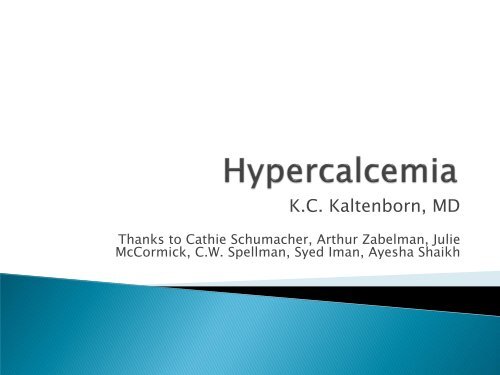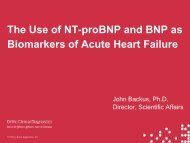K.C. Kaltenborn, MD - Clinical Laboratory Scientists of Alaska
K.C. Kaltenborn, MD - Clinical Laboratory Scientists of Alaska
K.C. Kaltenborn, MD - Clinical Laboratory Scientists of Alaska
Create successful ePaper yourself
Turn your PDF publications into a flip-book with our unique Google optimized e-Paper software.
K.C. <strong>Kaltenborn</strong>, <strong>MD</strong>Thanks to Cathie Schumacher, Arthur Zabelman, JulieMcCormick, C.W. Spellman, Syed Iman, Ayesha Shaikh
Review epidemiology, physiology, treatment<strong>of</strong> hypercalcemia
1. Changes in laboratory techniques since 2010have labeled more <strong>Alaska</strong>ns with hypercalcemia2. Repeat measurement <strong>of</strong> calcium is prudentbefore labeling the patient as abnormal, esp ifCa < 10.63. History, PE, PTH fully characterizes 90% <strong>of</strong>hypercalcemic patients4. Very high PTH can be a completely normalresponse to a physiologic state5. Measure 24 hour urine calcium beforeparathyroid surgery to rule out a low level =surgical non-responder (FHH)
60 yo man with diabetes Meds norvasc, metformin, lisinopril, toprol,niaspan, synthroid, caltrate, multivits,glucosamine and asa 2009: Ca 9.4 2011: Ca 10.4, repeat 10.5 PTH 27 Repeat Ca at different lab: 9.7
Evaluation <strong>of</strong> a patient with hypercalcemiashould include a careful history andphysical examination focusing on clinicalmanifestations <strong>of</strong> hypercalcemia, riskfactors for malignancy, causativemedications, and a family history <strong>of</strong>hypercalcemia-associated conditions
If calcium is > 12 mg/dl, one may see:Neurol Lethargy, confusion, comaPsych Depression, psychosisCardiol HypertensionNephrol DI, nephrolithiasisGI Nausea/emesis, PUD, anorexiaConstipation, pancreatitisRheum Proximal weakness, bone loss
Approx. 90% <strong>of</strong> all cases are caused byMalignancy or Primary Hyperpathyroidism V Vitamins I Immobilization T Thyrotoxicosis A Addison’s disease M Milk-alkali syndrome I Inflammatory disorders N Neoplastic related disease S Sarcoidosis T Thiazide,other drugs - Lithium R Rabdomyolysis A AIDS P Paget’s disease,Parental nutrition,Pheochromocytoma,Parathyroid disease
60 yo man with diabetes Meds norvasc, metformin, lisinopril, toprol,niaspan, synthroid, caltrate, multivits,glucosamine and asa 2009: Ca 9.4 2011: Ca 10.4, repeat 10.5 PTH 27 Repeat Ca at different lab: 9.7
2011: Calibration <strong>of</strong> serum by NationalInstitute <strong>of</strong> Standards Result: Reduce level <strong>of</strong> calcium by 0.2 mg/dl Providence Hospital◦ 2011: ULN 10.3◦ 2012: ULN 10.5
2011 <strong>Alaska</strong> Health Fair◦ Ambulatory health fair patients◦ 62/6500 had elevated calcium (0.95%) Providence 2012◦ Ambulatory patients◦ 1/100 elevated (1%)
TimeFrameNMeanMg/dlMedianMg/dl%> 10.22/2011 37,415 9.48 9.59 3.761/8/12-1/21/121/27/12-2/8/1217,294 9.30 9.30 1.9120,100 9.28 9.30 1.82Zabelman, Lab Corps, personal communication
Proposal: If Calcium ≤ 0.2 mg/dl above ULN,refrain from labeling the patient as abnormal,especially if an isolated finding inunremarkable case◦ i.e., no known active cancer, elevated creatinine,new or progressive anemia
Ask about medications:◦ Thiazide, lithium◦ Excessive use <strong>of</strong> Vitamin A, D, calcium or alkali Review prior labs: chronic elevationconsistent with primary hyperparathyroidism Repeat calcium (at a different lab?) possiblywith PTH Look at any change in normal range withsuspicion
If mild hypercalcemia appears to beincreasing, consider contacting lab manageror supervising pathologist◦ “Has frequency <strong>of</strong> abnormal calciums per monthincreased?”◦ “Is there a new method in use?”◦ “Has average calcium level per month drifted up?”
PTH $212 24-hour urine calcium/Cr $77 PTH-rp $149 25-D $146 SPEP $125 Ionized calcium $66 Phosphorus $38 1-25 D $289 ACE level $68 SPEP with immun<strong>of</strong>ixation $269 UPEP/immun<strong>of</strong>ixation $267 Kappa light chains, blood/urine $198 Radiology: PTH scan (sestamibi) $2800Lab tests per private ANC clinic; radiology costs Providence 3/12
Fenton, The cost <strong>of</strong> satisfaction, ArchivesInternal Med, Feb, 201234,000 patients for 4 years Answer: Probably yes But◦ The “most satisfied” patients had• 12% higher inpatient admissions• 9% higher drug, health care expenditure• 26% higher mortality
Most important test is PTH 90% <strong>of</strong> cases are◦ Primary hyperparathyroidism, or◦ Hypercalcemia <strong>of</strong> already evident malignancy
If Calcium > 0.2 mg/dl above normal,measure PTH (with calcium) If PTH high or high normal: dx primaryhyperparathyroidism◦ If surgery needed, measure 24 hour urine forcalcium
If PTH is low or low normal (< 20 ng/ml) Refer: patient will ultimately need a specialist◦ Oncology, renal, endocrinology Measure PTH-rp◦ (Breast, colon, renal carcinoma)
If PTH and PTH-rp unrevealing Refer Labs 25-D, 1,25-D, TSH, myeloma labs Review table 1 for rare causes
A serum calcium > 12mg/dl Hypercalciuria > 400mg/d Presence <strong>of</strong> sign and symptoms--S,B,G,M Markedly reduced cortical bone density Hypercalcemia causing decreased GFR Patient age under 50 years?NIH consensus development conference recommendation
63 year old woman Normal physical exam Calcium 10.8 (was10.5 three years prior) PTH 66 BMP, CBC normal No “bones, stones, moans, groans” T scores -2.3, -1.6; FRAX 10/1.5% Patients choses observation only Measure calcium 2x yearly, hydrate, care withthiazides, Vit D < 600 IU per day, Dexa q 2 years
40 yr male is seen as a new patient to establishcare. He has no complaints. PMHx is negative Baseline laboratory studies are significant forserum calcium <strong>of</strong> 11.5 mg/dL Physical examination is normal What is the most common cause <strong>of</strong> asymptomatichypercalcemia? This patient’s PTH would bea. Highb. Normalc. Low
Predict the PTH values if this patient’shypercalcemia was due to:a. Primary hyperparathyroidismb. Malignancyc. Vit D intoxicationd. Granulomatous diseasee. Hyperthyroidism
57 yo man with inconclusive GI evaluation,intermittent symptoms 12/21/11: 10.3 H (8.6-10.2) 1/12/12: PTH 122 H (10-65) 1/12/12: Unnecessary labs are ordered: Phos,SPEP, ionized Ca; all normal Consult 2/22/12: Ca (different lab) 9.6 (8.5-10.5) Vit D 7ng/ml L (30-100): similar pattern seenin gastric bypass, sprue patients
‣ Hydration‣ Furosemide‣ Bisphosphonate‣ Calcitonin‣ Steroids‣ DialysisSyed Nasrat Imam,<strong>MD</strong>
60 yo man with diabetes Meds norvasc, metformin, lisinopril, toprol,niaspan, synthroid, caltrate, multivits,glucosamine and asa 2009: Ca 9.4 2011: Ca 10.4, repeat 10.5 PTH 27 Repeat Ca at different lab: 9.7
1. Changes in laboratory techniques since 2010have labeled more <strong>Alaska</strong>ns with hypercalcemia2. Repeat measurement <strong>of</strong> calcium is prudentbefore labeling the patient as abnormal, esp ifCa < 10.63. History, PE, PTH fully characterizes 90% <strong>of</strong>hypercalcemic patients4. Very high PTH can be a completely normalresponse to a physiologic state5. Measure 24 hour urine calcium beforeparathyroid surgery to rule out a low level =surgical non-responder (FHH)
56 yo woman with long standing diabetes,hypertension, hyperlipidemia, hypothyroidism Biopsy <strong>of</strong> liver 11/2011 shows cirrhosis No known history <strong>of</strong> liver disease Negative hepatitis screen, iron pr<strong>of</strong>ile normal Positive ANA
Labs 1/10/2012◦ Creatinine 1.8◦ Calcium 11.8◦ PTH 3.0◦ PTH-r 0.3 Labs 1/12/2012 (diuretics, Ca, Vit D stopped)◦ Cr 1.4◦ Ca 10.4
Additional follow up labs◦ Ca 10.4—remains elevated◦ Cr 1.4—remains elevated◦ Double stranded DNA positive◦ Anti-smooth muscle antibodies negative◦ Anti-mitochondrial antibodies negative Referred to nephrology Considering diagnosis <strong>of</strong> mixed autoimmunedisease or lupus nephritis
A renal biopsy was done









